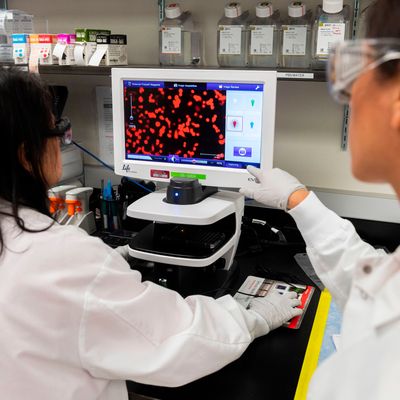
We’re committed to keeping our readers informed.
We’ve removed our paywall from essential coronavirus news stories. Become a subscriber to support our journalists. Subscribe now.
The world is watching the medical science community closer than ever, looking for every morsel of hope as researchers race to develop a treatment for COVID-19. Just this week, the CEO of Moderna, a biotech company with a vaccine that began human trials last month, said that her company could begin distributing its vaccine to health-care workers as soon as this fall. On Thursday, Stat News reported that an antiviral medicine developed by Gilead Sciences is getting positive results in clinical trials on severe coronavirus patients. On Friday, French drugmaker Sanofi said that it could produce 600 million doses of its vaccine next year, if it clears its clinical trials. To sort through all of the news, Intelligencer spoke to Dr. Peter Hotez, dean of the National School of Tropical Medicine at Baylor College of Medicine and co-director of Texas Children’s Hospital Center for Vaccine Development, where he is developing a coronavirus vaccine.
What do you make of the news that patients in a remdesivir trial are making rapid recoveries?
Remdesivir is an interesting drug because it actually works by inhibiting an enzyme that the virus needs to replicate, so it makes sense that this could have some antiviral activity. This is opposed to things like chloroquine or ivermectin — some of the other things you’ve been hearing about — where there would be no specific reason why they would work for COVID-19. Remdesivir is actually designed as an antiviral drug, so the fact that you are seeing some clinical-therapeutic effect is a good sign.
This was a study of about 125 patients with COVID-19. Of those, 113 had severe disease and they were treated with daily infusions of remdesivir. The point is, most of those patients have been discharged and only two of the patients died. That’s a fairly low mortality rate for 113 patients. The problem is, this is not a published study. We don’t have a lot of information about what actually happened from these results. There’s some initial promise but, again, we’re going to need a lot more information before we can say anything definite.
We talk a lot about the timeline of vaccines, what about treatments like remdesivir — what kind of role will they play in reducing the death toll of a second wave?
Something like remdesivir, right now, as it’s currently being looked at, is a treatment for ill patients — it’s not really being used as a preventive. That’s not to say it couldn’t one day be advanced as a preventive. What do I mean by preventive? We have, for instance, for HIV/AIDS, things like PrEP. We’re not there yet, but there is evidence that this is showing some benefit. We’ll have to see.
What kind of timeline are we looking at for a treatment like that? Can we look for something in the fall?
Potentially. It all depends on how quickly we can accumulate the data. Right now, the attack rate is pretty high so we’re going to get a lot more information over the next few weeks. Remember, this may be our one window when we’ll be able to get that information. If everybody practices social distancing, and transmission goes down, it will be more difficult to enroll lots of patients after June.
What do you think of chloroquine as a treatment?
It’s not a matter of what I think. I haven’t seen any large, well-controlled studies that point to its effectiveness. There’s been a couple of small studies with a hint of effectiveness, which have been shown to exhibit replication in the laboratory. But it’s fairly toxic at high doses and there’s no particular reason why the drug would work, other than the fact that it has shown some effects of inhibiting the replication of the virus in the test tube. But it did that for influenza as well and it never really panned out. Given that history, and the fact that we’ve only really had a few small studies and it’s fairly toxic at high doses, and there’s no particular reason why it should work against the virus, I would put chloroquine at a much lower likelihood.
Are there any other promising treatments in trials right now?
I’m a vaccine person, not a small molecule drug person, but there are other antiviral drugs being looked at right now. In fact, there’s something that the WHO has called the solidarity study. This is a solidarity clinical trial for treatments. There are 90 countries that are participating and they’re looking at remdesivir, chloroquine, and a combination of antiviral drugs called lopinavir and ritonavir, and then they’re looking at it with an interferon beta.
Earlier this week, Dr. Fauci said that it’s possible a vaccine could be available sooner than the 12-to-18-month window he and many others have talked about. What do you think accounts for that possibility?
We’re making a vaccine and we’re working late into the night and up early in the morning trying to move this vaccine into clinical trials, trying to meet Dr. Fauci’s aspirational goal. We’re going to do our best but it really depends on how things progress in terms of evidence of safety and also efficacy.
The CEO of Moderna reportedly told Goldman Sachs that the company’s vaccine could be available for emergency use on health-care workers as early as this fall. How would a limited roll-out like that work?
I don’t know. As it is, 12 to 18 months would be a record. It is possible, after a year or 18 months, to get an efficacy signal that a vaccine shows some effect to prevent the infection? The key is going to be showing that it’s safe. To show all of those things in a year to 18 months would be unprecedented. I don’t know what kind of data he’s looking at in particular.
Our vaccine could be ready by the fall as well. We’ll have up to 200,000 doses. But unless you’ve shown that it actually works and unless you’ve shown that it’s safe, you’re not going to do that. Without having the efficacy and safety data, I think you have to be really careful about bold statements like that. As I often like to say, these nucleic acid vaccines have been around for 30 years and they offer great promise, they work in laboratory animals, but, historically, they have not worked well in people. Maybe now there’s been modifications to improve that. Let’s wait and see.
Should we be concerned that this expediency factor, loosening regulations or foregoing animals trials, might impact public safety?
The biotechs are being very aggressive in their press statements. What they’re doing is talking to their investors. I think you have to filter that away from what the FDA is thinking. A wishlist from the CEO of a biotech or a pharma company means nothing to me. It’s what the clinical trialists are finding in collaboration with the FDA that matters.
So there’s nothing that the FDA has done to the process that significantly changes the safety standards of these trials.
I don’t know. I don’t have access to that information. But the branch of the FDA called the Center for Biologics Evaluation and Research has been around for a while and has some of the smartest vaccine scientists that I’ve ever worked with. I’m fairly confident they would not do anything that would jeopardize the health and safety of Americans. I tend not to pay attention to the statements from the CEOs of biotech and pharma companies. They’re talking to their shareholders.
Once a vaccine is available, how will it be administered in the United States?
Ultimately, there will be more than one vaccine. There could be several vaccines that have different uses. Some vaccines might be used for older Americans at risk of disease or those with underlying comorbid conditions like diabetes or obesity. There might be some use for younger adults. Maybe some for health-care workers. Same with the other technologies that we’re talking about, like remdesivir, there may be a prophylactic use for it as well. All of this is being accelerated through a lot of studies in parallel and we’ll have to see how the target product profiles will look.
Is everyone going to go to Walgreens at once? Or will it be gradually expanded by targeting vulnerable populations?
I don’t think those kinds of decisions have been made yet. Right now, there’s a focus on trying to shape the target product profile on the populations that have to be prioritized. You also have to worry about the fact that COVID-19 is a global health problem. Some of these vaccines are very high tech and may not be available for people in the poorest countries — places like India, Bangladesh, and Ecuador. That’s one of the things we’re trying to do, develop the first global health vaccine
What’s the biggest challenge to doing that?
Let me give you the flip side of that. Our vaccine uses the same technology as the recombinant protein hepatitis B vaccine that’s made all over the world. It’s made in Brazil, it’s made in India. We did that deliberately so we could have a global health vaccine that could be made locally. Right now, I’m not aware of any capability of that capacity for some of the vaccines now being ruled out. It’s not so much that it’s hard to make a piece of DNA or RNA, it’s the kind of unique packaging that they’re doing to make it work in people. In the past, RNA and DNA vaccines have worked well in mice, but not well in people. They say they have evidence through the different kinds of the constructs they have in the packaging that it can improve efficacy. How easy it is to scale that up for low and middle income countries, for me, is a total unknown.
Will we experience anything that resembles everyday life before a vaccine is distributed?
I think so. I think what we’re going to see is, as transmission goes down because of the social distancing and the economy opens up, you’ll see parts of American life restored to some level of normalcy. It will be different in the sense that we’ll probably have to figure out a way to do testing on a regular basis and then have individuals responsible for tracing down contacts, and the contacts of the contacts of infected individuals. There will need to be some adjustment. And the virus could come back next year or the year after that. There’s some models coming out of Harvard to suggest that’s a high probability. Things won’t be the same for a couple of years. It’s not clear that this virus will be around forever and we’ll have a whole array of new technologies to apply to it.
The one piece that we’re focusing on that you’re not hearing anything about is the fact that we’re all focused on what to do for the United States. I understand that emphasis, but I’m very worried when I hear stories of bodies piling up in Guayaquil, Ecuador. Or how are you going to implement social distancing in the crowded urban areas of Mumbai, Dhaka, or Lagos. That’s where we’re coming in. We’re using our expertise in developing low-cost global health vaccines to see how we can also take on that component of the pandemic. The frustration that we have is that even now we’re still struggling to raise money to do our clinical trials. That’s unfortunate, even at this stage.






























